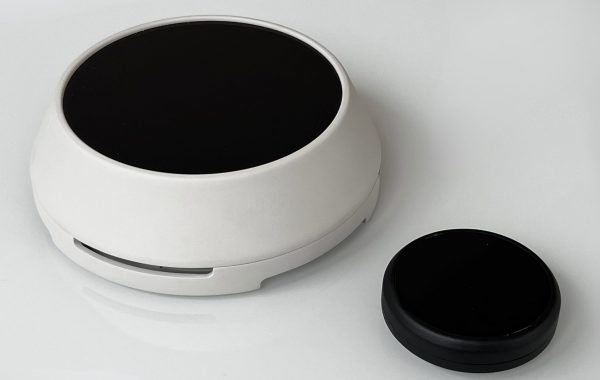LiFi Technology
What is LiFi Technology?
LiFi (Light Fidelity) is a wireless communication technology that uses light waves instead of radio signals to transmit data. By modulating light intensity at high speeds, it enables secure, fast, and interference-free connectivity, making it an innovative alternative to traditional wireless networks.
A Simple Explanation of How LiFi Technology Works

How Does LiFi Work?
LiFi (Light Fidelity) is a wireless communication technology that uses light to transmit data. Data is encoded into light waves by a LiFi Access Point and transmitted to a device. The device, equipped with a Dongle, receives the light signals via a photodetector and converts them back into data.
Several users can be connected per Access Point, and seamless handover between Access Points creates a connectivity experience that is known from conventional WiFi or cellphone networks. The number of possible users per Access Point is rising rapidly with the evolution of the LiFi technology.
For maximum performance in data rate, a free line of sight is required between the Access Point and Receiver. However, indirect transmission (i.e., by reflection) is also possible for low data rate applications.
LiFi offers fast, secure, and interference-free communication, with data transfer occurring through direct light or reflected light, though a line of sight is ideal for maximum performance.
Advantages of LiFi Technology

Fast Data transfer
LiFi offers fast data transfer speeds. Leveraging the broad bandwidth of visible light, LiFi enables high-speed internet and efficient data transmission.

Enhanced Security
LiFi enhances network security by using visible light communication that is confined to specific areas. This reduces the risk of unauthorized access compared to WiFi's radio frequency signals.

Free from RF Interference
LiFi is immune to radio frequency interference, operating in the visible light spectrum. This ensures a stable and reliable wireless connection, free from common WiFi interference issues.

Reliable Stability
LiFi keeps your connection strong and steady, free from interference and unexpected dropouts. Enjoy seamless performance without disruptions.
Use Cases of LiFi

Industries

Smart Homes & Hotels

Underwater Communications

Gaming

AR & VR

Network

Smart Lightning

Customized Solutions
Experience LiFi Technology Yourself
Enjoy the speed, security, and innovation of LiFi technology with our Starter Kit, designed to transform the way you connect and communicate.

F.A.Q.
Frequently Asked Questions
LiFi, short from “light fidelity”, is a wireless communication technology that uses infrared spectrum to transmit data at a high-speed.
A LiFi system consists of two main devices: an access point and a receiver (dongle).
The aeroLiFi access point transmits data using infrared light (not visible to the human eye) in both uplink and downlink directions. A dongle can be plugged into any device, like a laptop, mobile phone, or tablet, and can instantly establish a data connection with an access point. The dongle is plug-and-play, and no additional effort is needed to use it.
As soon as you install and connect the access points to your home network and also connect the dongle via USB to your end device you are ready to use LiFi.
Unlike radio waves, light waves are blocked by physical barriers like walls or shaded windows. This makes it possible to contain the signal in an enclosed area, minimizing the risk of network penetration and jamming.
No, the human eye cannot see LiFi signals. LiFi uses light waves at frequencies that are beyond the range of human vision in the infrared spectrum.
LiFi technology can work not only in daylight but also in direct sunlight, as the modulated light can still be detected.
LiFi is based on recognizing rapid changes in light intensity, not absolute or slowly changing levels caused by natural defects in daylight or sunlight. LiFi modulates light at a high rates.
Since sunlight is constant light, it can therefore be filtered by the receiver.
LiFi devices have the advantage of not requiring a direct line of sight between the transmitter and receiver, as they can receive signals that bounce off other surfaces. However, the data transfer rate depends on the signal strength, which, in turn, is affected by the quality of the connection to the light source. Any interference or signal degradation can lead to slower data transmission, with weaker signals resulting in slower rates, while stronger signals typically offer faster data transmission.
Masking a dongle, such as placing a sheet of paper over it, can indeed obstruct its ability to pick up signals effectively. This action essentially blocks the light signals from reaching the dongle, causing a loss of connectivity or data transmission in LiFi technology.
Yes, LiFi can be integrated with existing infrastructure. LiFi technology uses standard LED light fixtures, making it compatible with the existing lighting infrastructure in homes, offices, and public spaces. This means it can be deployed with some modifications to the existing infrastructure.
From the point of view of the end user, LiFi technology is similar to WiFi. The main technical difference is that LiFi uses light waves, while WiFi uses radio frequencies to transmit data.
Yes, LiFi and WiFi can coexist in the same environment without interference. In fact, they can complement each other by providing high-speed data transfer through LiFi in areas where it’s most needed and traditional WiFi for broader coverage. The big benefit of having both technologies is that if one stops working, another one takes over all traffic connections, so you don’t have to worry about problems with connectivity.
LiFi is considered safe for human health as it uses visible and infrared light for data transmission and does not emit harmful radiation. It is a low-risk technology in terms of health concerns.
LiFi technology is suitable for various applications, including indoor wireless communication in offices, hospitals and secure environments. It can also be used in underwater communication and in places where RF signals are restricted or where WiFi signals cannot be reached.




